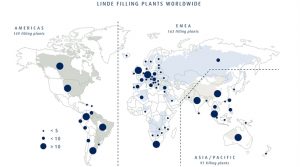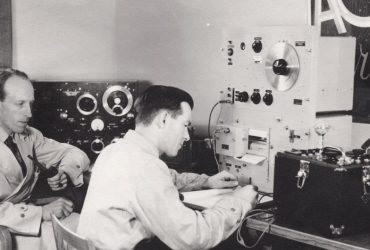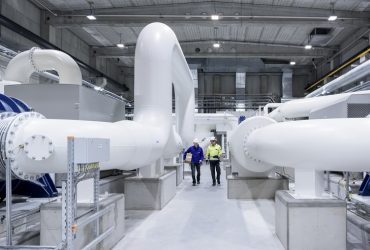Linde robots help lead the way into a new age of automation
In the current era of expanding digitalisation and automation, the daily work in factories and manufacturing plants is undergoing dramatic change. At Lindes filling plants, robots are starting to take over the heavy lifting activities – resulting in fewer accidents and increased efficiency.
Long gone are the days when the work in a manufacturing plant was slow, strenuous and laborious, suitable only for the sturdiest among us. These days, human muscle power is taking a back seat in one Linde most modern cylinder filling plants: the Riihimäki plant in Finland – the world’s first fully automated plant for gas cylinders.

This six-axis robot, a world-first application, transforms the way cylinders are sorted, picked and moved.
“One of our main aims by introducing the new level of automation was to reduce the number of manual handling steps at the stations,” explains Peter Dunn, Manager Regional Engineering at BOC Australia. “The heavy labour takes its toll on our workers – especially those who have been doing it over time.” With gas cylinders weighing between 30 and 50 kilos, hauling them about is certainly not ideal for the shoulders, elbows, wrists or feet. “By automating various process steps, we are significantly reducing the risk of incidents.”
Having undergone a complete overhaul, the Finnish plant, which produces more than 200 different gas mixtures and nearly 700,000 cylinders per year, is the first-ever fully automated filling plant for gas cylinders in the world. The cornerstone of the modernised plant is its automated filling equipment – known as the carousel.
Before a cylinder is filled, it is inspected by a scanner, and, once it passes the test, the machine attaches an adapter to it. The carousel has two different filling points, which can use different gas mixtures at one time. The robotic system can store up to 3,200 cylinders and also remembers the exact client and destination for every single cylinder. When the time comes to deliver the gas, the robot sends the ordered products to self-operating vehicles, or automated guided vehicles (AGVs), which, in turn, bring the cylinders to the terminal where the order is loaded for delivery.
The re-vamp has significantly changed the day-to-day life of the people working at the Riihimäki plant. With machines handling the movement of heavy cylinders, much of the lifting and risky work is removed from the human workers. The machinery is quieter, while updated lighting has created a more comfortable working environment.
Linde has always upheld safety as a priority, and the fully automated plant has taken this to a new level – something that is already reflected in the Linde Group’s internal statistics. While there were 150 forklift-related accidents worldwide in 2013, the number in 2017 was down by half – an improvement that is in part thanks to the use of AGVs.
How has the working environment in Riihimäki improved since automation was improved? What advantages have you seen so far in terms of efficiency, productivity and job satisfaction?
Automation is not only helping to reduce the risk of injuries. It is also a game changer for Lindes customers. Robots, sensors, and 3D cameras are all cutting-edge features of an emerging new machine age and, together, they deliver unseen efficiency gains, higher quality levels and greater flexibility. Automated processes also enable the production of smaller, customised orders, with shorter lead-times, when necessary.

Molecules don’t like to travel. Linde therefore distributed its filling plants across the globe.
The Riihimäki plant is part of an automated plant family within the Linde group spread across different regions around the world, from Sydney (Australia), to Enköping (Sweden), as well as Marl and Unterschleißheim (Germany) to name just a few. Each family member is bringing in new automated solutions that will help revolutionise the way cylinder plants operate in future.



